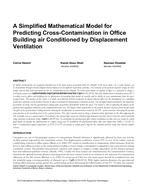Description
In indoor environments, the occupants constitute one of the main sources of particles from the ultrafine to the coarse mode. As a result, diseases can be transmitted through exhaled droplets nuclei produced by the different respiratory activities. The behavior of the particles depends largely on their weight and the flow field determined by the air conditioning system adopted. To insure good indoor air quality (IAQ) it is advisable to design a ventilation system covering the inhalable range of particle diameters lower than 15μm (4.92×10-5ft). Recently, displacement ventilation system (DV) is widely used in offices and buildings for its effectiveness in providing high indoor air quality and its ability to carry contaminants from the lower occupied zone. The purpose of this work is to study cross-infection between occupants in typical internal offices by the development of a simplified model that simulates active particle behavior in spaces ventilated by displacement ventilation system. The developed model incorporates the deposition of particles on walls and the gravitational settling effect on particles distribution within the space. The model is able of capturing the physics of the problem with significant reduction of the computational time cost. The model results showed that as the particle diameter increases from the fine mode the effect of the gravitational settling increases reducing the stratification in concentration created by the DV system and thus increasing the particle concentration at the breathing level of the exposed person. This effect remains until reaching a diameter where deposition on the floor opposing the DV principle acts as a removal factor. Nevertheless, the removal effect occurs for relatively high diameters and thus doesn’t cover the critical inhalable range (particles of diameter below 10μm (3.28×10-5ft). To overwhelm the gravitational effect, higher ventilation air flow rates are needed to satisfy good indoor air quality but unfortunately at a higher energy cost. To overwhelm the gravitational effect, flow rates higher than 100L/s (3.53ft3/s) with a recommended supply temperature of 22°C(71.6°F) are needed to satisfy good IAQ for the inhalable particle range and thermal comfort criteria.
Citation: International Conference on Efficient Building Design, Materials and HVAC Equipment Technologies; October 2-3, 2014; Beirut, Lebanon
Product Details
- Published:
- 2014
- Number of Pages:
- 8
- File Size:
- 1 file , 950 KB
- Product Code(s):
- D-ICEB14-01




